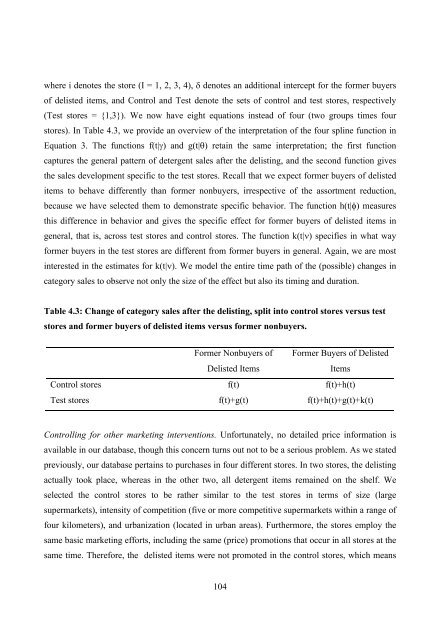Understanding Consumer Reactions to Assortment Unavailability
Understanding Consumer Reactions to Assortment Unavailability
Understanding Consumer Reactions to Assortment Unavailability
You also want an ePaper? Increase the reach of your titles
YUMPU automatically turns print PDFs into web optimized ePapers that Google loves.
where i denotes the s<strong>to</strong>re (I = 1, 2, 3, 4), δ denotes an additional intercept for the former buyers<br />
of delisted items, and Control and Test denote the sets of control and test s<strong>to</strong>res, respectively<br />
(Test s<strong>to</strong>res = {1,3}). We now have eight equations instead of four (two groups times four<br />
s<strong>to</strong>res). In Table 4.3, we provide an overview of the interpretation of the four spline function in<br />
Equation 3. The functions f(t|γ) and g(t|θ) retain the same interpretation; the first function<br />
captures the general pattern of detergent sales after the delisting, and the second function gives<br />
the sales development specific <strong>to</strong> the test s<strong>to</strong>res. Recall that we expect former buyers of delisted<br />
items <strong>to</strong> behave differently than former nonbuyers, irrespective of the assortment reduction,<br />
because we have selected them <strong>to</strong> demonstrate specific behavior. The function h(t|φ) measures<br />
this difference in behavior and gives the specific effect for former buyers of delisted items in<br />
general, that is, across test s<strong>to</strong>res and control s<strong>to</strong>res. The function k(t|ν) specifies in what way<br />
former buyers in the test s<strong>to</strong>res are different from former buyers in general. Again, we are most<br />
interested in the estimates for k(t|ν). We model the entire time path of the (possible) changes in<br />
category sales <strong>to</strong> observe not only the size of the effect but also its timing and duration.<br />
Table 4.3: Change of category sales after the delisting, split in<strong>to</strong> control s<strong>to</strong>res versus test<br />
s<strong>to</strong>res and former buyers of delisted items versus former nonbuyers.<br />
Former Nonbuyers of<br />
Delisted Items<br />
104<br />
Former Buyers of Delisted<br />
Items<br />
Control s<strong>to</strong>res f(t) f(t)+h(t)<br />
Test s<strong>to</strong>res f(t)+g(t) f(t)+h(t)+g(t)+k(t)<br />
Controlling for other marketing interventions. Unfortunately, no detailed price information is<br />
available in our database, though this concern turns out not <strong>to</strong> be a serious problem. As we stated<br />
previously, our database pertains <strong>to</strong> purchases in four different s<strong>to</strong>res. In two s<strong>to</strong>res, the delisting<br />
actually <strong>to</strong>ok place, whereas in the other two, all detergent items remained on the shelf. We<br />
selected the control s<strong>to</strong>res <strong>to</strong> be rather similar <strong>to</strong> the test s<strong>to</strong>res in terms of size (large<br />
supermarkets), intensity of competition (five or more competitive supermarkets within a range of<br />
four kilometers), and urbanization (located in urban areas). Furthermore, the s<strong>to</strong>res employ the<br />
same basic marketing efforts, including the same (price) promotions that occur in all s<strong>to</strong>res at the<br />
same time. Therefore, the delisted items were not promoted in the control s<strong>to</strong>res, which means

















